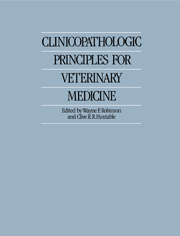Book contents
- Frontmatter
- Contents
- Contributors
- Preface
- Acknowledgements
- 1 The relationship between pathology and medicine
- 2 The immune system
- 3 The hematopoietic system
- 4 Acid–base balance
- 5 The respiratory system
- 6 The cardiovascular system
- 7 The alimentary tract
- 8 The liver and exocrine pancreas
- 9 The urinary system
- 10 The endocrine glands
- 11 The skin
- 12 The skeletal system
- 13 The nervous system
- 14 Muscle
- 15 Metabolic disease
- 16 The reproductive system
- Index
5 - The respiratory system
Published online by Cambridge University Press: 19 January 2010
- Frontmatter
- Contents
- Contributors
- Preface
- Acknowledgements
- 1 The relationship between pathology and medicine
- 2 The immune system
- 3 The hematopoietic system
- 4 Acid–base balance
- 5 The respiratory system
- 6 The cardiovascular system
- 7 The alimentary tract
- 8 The liver and exocrine pancreas
- 9 The urinary system
- 10 The endocrine glands
- 11 The skin
- 12 The skeletal system
- 13 The nervous system
- 14 Muscle
- 15 Metabolic disease
- 16 The reproductive system
- Index
Summary
The major function of the respiratory tract is to facilitate the exchange of O2 and CO2 between the blood and the atmosphere. The tract has two major functional divisions: a gastransport system comprising the nasal cavity, larynx, trachea, bronchi and bronchioles and a gaseous exchange system comprising alveolar ducts and alveoli. The transport system not only carries gases but also warms, humidifies and filters them. Gaseous exchange in alveoli is maximized by a large surface area and a thin gas-exchange barrier (Fig. 5.1).
Clinical signs of respiratory tract disease depend upon the level (or levels) of the tract involved as well as upon the nature, severity and duration of the insult. In the gas-transport system, involvement of a small area may produce major clinical signs; for example, a local foreign body or area of inflammation in the nasal cavity, larynx, trachea or bronchi can produce violent sneezing, coughing or dyspnea. By contrast, large areas in the lungs may be diseased with little functional impairment. For instance, when there is pulmonary neoplasia, signs of respiratory failure may not appear until two-thirds of the lung tissue are involved.
Not all diseases of the respiratory tract produce clinical signs that might be expected. For instance, in farm animals, chronic bronchopneumonia is common and is usually manifest clinically by illthrift, rather than by coughing and dyspnea. The latter are not evident until the animal is forcibly exercised, which seldom occurs under most conditions of management.
- Type
- Chapter
- Information
- Clinicopathologic Principles for Veterinary Medicine , pp. 99 - 121Publisher: Cambridge University PressPrint publication year: 1988



